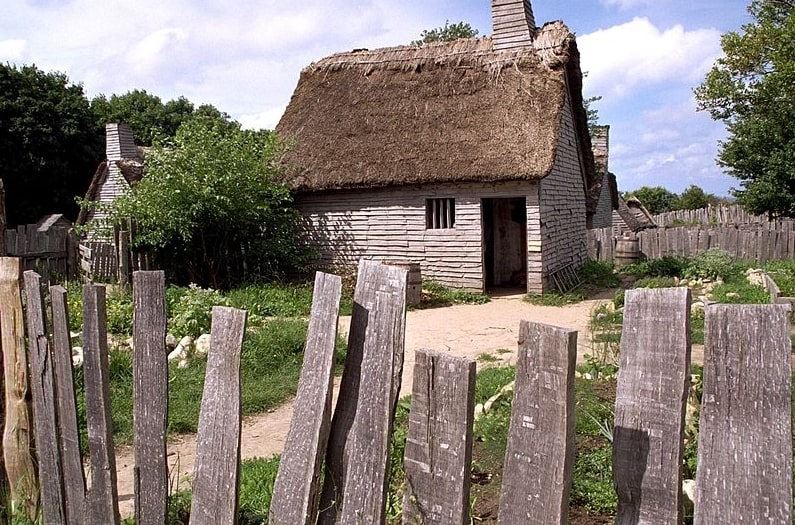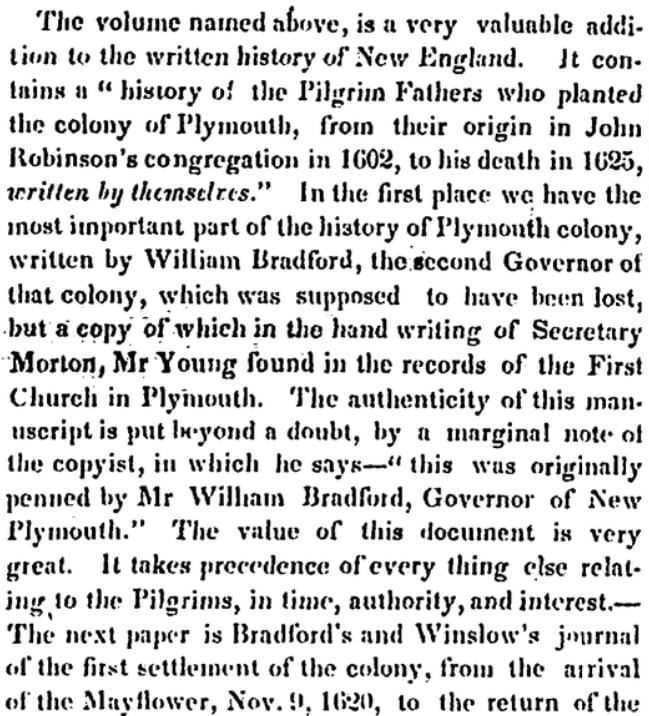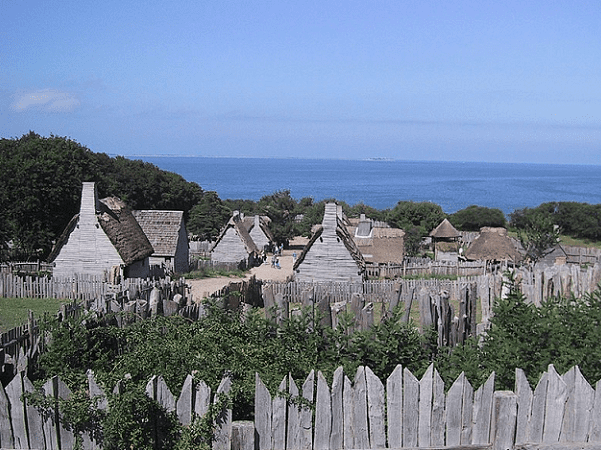Introduction: In this article – to continue the celebration the 400th anniversary of the arrival of the Mayflower – Jane Hampton Cook writes about a discovery she made about the history of the Pilgrims and Thanksgiving. Jane is a presidential historian and author of ten books, including her new book Resilience on Parade: Short Stories of Suffragists & Women’s Battle for the Vote. She is the author of Stories of Faith and Courage from the Revolutionary War. She was the first female White House webmaster (2001-03). Her works can be found at Janecook.com.
In searching through historical newspapers to write articles about Thanksgiving for the GenealogyBank Blog, I unexpectedly made a new discovery about Thanksgiving history that was confirmed by the Plimoth Pawtuxet Museum.

Most of what we know today about the Pilgrims’ first Thanksgiving comes from Chronicles of the Pilgrim Fathers, a book published by Alexander Young in 1841. GenealogyBank’s Historical Newspaper Archives tell us, via an announcement in the 13 July 1841 edition of the Newburyport Herald, that this book included portions of the lost writings of the Pilgrims.

As this article reported:
“In the first place we have the most important part of the history of Plymouth colony, written by William Bradford, the second Governor of that colony, which was supposed to have been lost.”
The original manuscript of Bradford’s Of Plymouth Plantation had been lost during the Revolutionary War, only to be discovered in England in the Bishop of London’s library in 1844. However, the Newburyport Herald article noted that Alexander Young had discovered a copy of Bradford’s manuscript “found in the records of the First Church in Plymouth.”
Chronicles of the Pilgrim Fathers also included a long-lost 1621 letter by Edward Winslow, a Pilgrim who wrote about their three-day Thanksgiving feast. Winslow’s letter had been originally published (without his permission) in England – but not in America – in a 1622 pamphlet. When a copy of this pamphlet was discovered, Young compiled Bradford’s and Winslow’s writings into his book.
This article also reported:
“Added to these are several other rare tracts, some of which are not to be found in print in this country, and a part of which are now for the first time published.”
Because of Winslow’s recovered letter, Chronicles of the Pilgrim Fathers claimed in 1841 that the Pilgrims had held the first Thanksgiving in America in 1621. This discovery launched an explosion of interest in the Pilgrims, forever linking them with Thanksgiving in the minds of Americans thereafter.
However, I found articles in GenealogyBank’s Historical Newspaper Archives that reported on the Pilgrim’s first Thanksgiving long before this 1841 Newburyport Herald article.
The articles I found were “breadcrumbs to the explosion” of interest in the Pilgrim’s first Thanksgiving, as Richard Pickering, deputy executive director of Plimoth Patuxet Museum, explained to me. I discovered these breadcrumbs using keyword searches of “Pilgrim” and “Thanksgiving” from 1700 to 1820.
With these searches, I found a handful of newspaper articles about Thanksgiving from 1816-20. One 1816 article clearly linked the Pilgrims to starting Thanksgiving. This claim was 25 years before the Chronicles book.
This article reported:
“This day is our annual public thanksgiving. If our Pilgrim forefathers, who instituted this religious festival, could give thanks, in a mere temporary hut in the midst of barrenness, that they were permitted to ‘suck nourishment from the treasures hid in the land,’ how much more should their descendants, who inherit from them a land now ‘flowing with milk and honey,’ enter with the voice of thanksgiving and praise those numerous temples since that day reared and dedicated to the worship of their Almighty Benefactor!”
Obviously, people in New England credited the Pilgrims with Thanksgiving before the discovery of Winslow’s lost letter that Young published in his book in 1841. Thanksgiving was a revered tradition in New England, and New Englanders carried it with them when they migrated West and South.
Another article I found about Thanksgiving in 1816 in the Vermont Intelligencer and Bellows’ Falls Advertiser published a speech describing the heartbreak and strength of the Mayflower Pilgrims.
Part of Nathaniel Chauncey’s speech contained these words:
“Of the adventurers who landed at Plymouth, half died in the first season, from accumulated hardships. But the survivors would not return [to Europe]. They had taken their lives in their hands and they were prepared for death in its most terrible form.”
Another article, from Poulson’s American Daily Advertiser, reported in 1820 that New Englanders in Pennsylvania had recently celebrated the 200th anniversary of the Pilgrims’ landing “on the shores of New England.”
Connecting the Pilgrims to Thanksgiving, they toasted to:
“Thanksgiving – The anniversary of public gratitude, and fireside happiness.”
Cheers also to digitization today. Twenty years ago, reading historical newspapers was a manual process on microfilm. But today the digitization of historical newspapers, such as those in GenealogyBank, has opened the door to making better connections, understanding context, and sometimes making new discoveries – all at our fingertips.
Also, Plimoth Patuxet Museum and the State Library of Massachusetts recently jointly published a new facsimile of William Bradford’s Of Plimoth Plantation, commonly known as the Bradford Manuscript. For the first time in printed form since 1896, this volume presents the handwritten history of Plymouth Colony from William Bradford, Mayflower passenger and the colony’s longest-serving governor.
Explore over 330 years of newspapers and historical records in GenealogyBank. Discover your family story! Start a 7-Day Free Trial
Related Articles:
